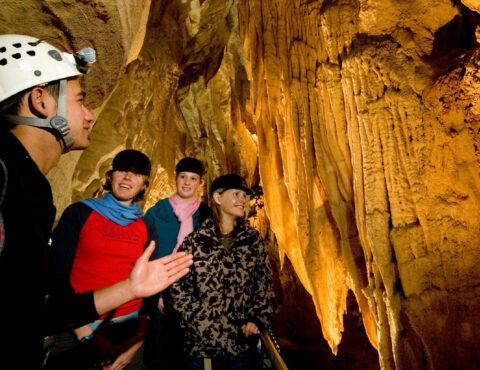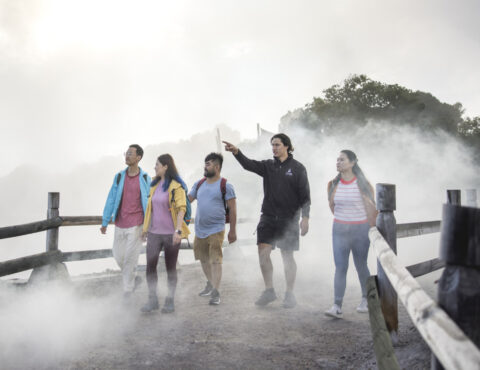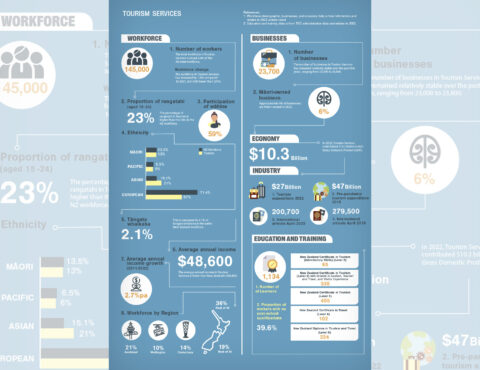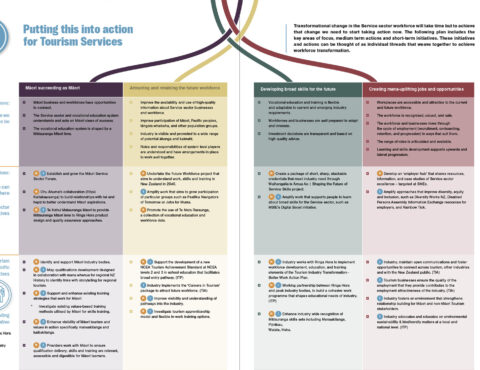Ringa Hora has worked with people from across industry to develop a shared roadmap to transform the Service sector workforce from its current state to the future that we aspire to.
The Workforce Development Plan looks across the Service sector and sets out the major factors shaping the sector and an overarching vision for the future.
Against that context, this Action Plan focuses on the characteristics and dynamics of the Tourism industry and its workforce. It describes what the future could look like for this workforce, the current challenges faced by the industry, and sets out the actions we can take to tackle this wero | challenge.
Ringa Hora’s Service Sector Workforce Development Plan is based on four aho | strands. Each of these aho will strengthen the workforce, but when woven together, as a taura whiri | rope, we can achieve real transformation of the workforce:
For Tourism services, this means ensuring that the future of the Tourism industry is one where it is recognised for providing skills for life; one where it effectively upskills the workforce and prepares them for the future of tourism. This includes a workforce which is regarded as culturally competent, authentic storytellers; is able to adopt new and emerging technology to help their businesses grow; and one where everyone working in the industry is proud to be working within the sector and has meaningful mana-uplifting mahi.

At its core, Tourism services is an industry where people interact and experience a variety of activities, predominantly leisure and recreational activities, entertainment, hospitality, retail, accommodation, and travel.
The industry is cross-cutting and crucial to the economy, attracting visitors and showcasing New Zealand on both a global and domestic scale. The industry was severely impacted by COVID measures and border closures, but is now bouncing back with the return of international visitors. Tourism contributes approximately $10b to the economy and it is only growing, with a predicted annual growth of 5.7 % between 2023–2028.
As an important economic growth driver, the tourism industry has been signalled as a Government priority in its economic strategy through the Tourism Industry Transformation Plan (ITP) and the subsequent He Mahere Tiaki Kaimahi | Better Work Action Plan.
Demand for tourism offerings is evolving. Customers are increasingly demanding more meaningful, connected experiences. As a result, there is a shift to smaller volume, higher yield tourism products. Māori tourism is already operating in this space with their histories, stories, world views and cultural experience forming an integral part
of New Zealand’s identity.

To help us get to the future state, we need to understand and tackle the challenges that the Tourism Services sector faces, while also seizing the opportunities that already exist or are on the horizon. We’ve heard that the factors which have a significant impact on the Tourism Services industry, including its approach to workforce development, include the need to attract and retain staff with skills that reflect industry needs, ensuring that these skills are developed and recognised in fit-for-purpose qualifications and training, supporting cultural competency and pursuing innovation.
Rebuilding capacity and capability
The industry was significantly impacted by COVID-19 lockdowns which caused the industry to lose a significant share of its workforce. The Tourism industry is now rebuilding and is projected to grow 5.7% annually between 2023 and 2028, but is struggling to attract and retain enough people with the right skills.
The Tourism Industry Association 2022 Workforce and Industry Readiness survey indicated the industry needed to fill approximately 1,400 roles. However, there is a general lack of applicants, with 61% of job applications receiving fewer than five applications per role.
Promoting career pathways and using seasonality to the industry’s advantage
Currently, many workers enter the industry short-term and are unclear how they can progress and develop their career in the industry. Showcasing pathways within the industry is fundamental to retaining these workers longer term and reducing industry churn. Some short-term employment patterns reflect seasonal peaks and troughs characteristic in the industry. However, these peaks could be used to the industry’s advantage by upskilling people to work across related industries and reducing barriers for people holding multiple jobs across the year.
Developing fit-for-purpose education and training
As the Tourism ITP highlights, people are the foundation of enabling the Tourism industry, and fit-for-purpose education and training is a priority that can promote transformational shifts. However, the number of tourism learners across tertiary education organisations in Aotearoa declined by 55%, from 4,625 in 2017 to 2,090 in 2021.
Industry is already reconsidering how qualifications and training are delivered, with a growing push for micro-credentials. These micro-credentials could cover topics like business management, leadership development, customer service, storytelling and many others.
Addressing the need for cultural competency and ensuring authentic storytelling
Improving cultural competency will build a better workplace culture for employees, where their cultural values (including Te Ao Māori values) are understood and respected. This will promote a more diverse and inclusive workplace more long-term.
In addition, this will enable the industry to tell more authentic stories. The industry contains many genuine, knowledgeable storytellers who have a connection to their whenua and who can genuinely incorporate Te Ao Māori views and perspectives into their offerings. There is scope to spread this knowledge further as there are still cases of businesses sharing stories and history without consideration for their cultural significance.
Recognising the need to lift technology uptake and innovation
Technology changes are impacting the way businesses run; with innovations such as the growing use of Artificial Intelligence and virtual reality. Early adoption gives the industry an advantage and is critical to progress. There are a range of opportunities to increase adoption of technology across the Tourism industry to boost business efficiencies and lead to better work, as well as to stimulate more innovation.
The heart of Tourism Services is person to person interaction and connections formed with people, places and experiences unique to Aotearoa. The Tourism industry employs around 145,000 people.
The industry workforce is youthful, with 27% of workers under the age of 24 and a total of 48% under 34 years old. This means the Tourism industry is well placed to uplift our rangatahi and provide them with the opportunity to gain skills and experience which will help them progress within their chosen career.
Embracing and celebrating diversity makes businesses more attractive to potential kaimahi and customers, as well as creating economic and social benefits for employers, the workforce, and the wider community.
Using workforce participation data as a starting point shows that there is work to be done in the Tourism Services industry to realise the aspirations and potential of Māori, Pacific peoples, and tāngata whaikaha | disabled people:
![]()
Connecting people through Māori tourism attracts visitors and embraces people who are regionally and locally based. Māori tourism is manaakitanga and kaitiakitanga in action.
NZ Māori Tourism identified 537 Māori tourism businesses in 2020, from small and medium businesses through to larger entities and iwi owned enterprises. More than half of the
Māori tourism sector are arts and recreational services, or accommodation and food
services industries.
![]()
There is a relatively low proportion of Pacific peoples in the industry. Many Pacific peoples in the industry have been disproportionately impacted by tourism job losses in recent years. Helping employers recognise, value and build skills in public speaking could help fill the skills shortage of guiding and storytelling. Upskilling the Pacific workforce already in the industry will support retention and promote progression into leadership and management roles.
![]()
Tāngata whaikaha includes physical, mental, intellectual, or sensory impairments which can impact a person’s life to varying degrees and in different ways. We acknowledge that data on tāngata whaikaha is limited and it is important that we create more growth opportunities within the sector for our tāngata whaikaha workforce.

Explore the Tourism industry workforce demographic, business, and economy statistics, and education and training data.

Transformational change in the Service sector workforce will take time but to achieve that change we need to start taking action now. The Tourism action plan includes the key areas of focus, medium-term actions and short-term initiatives. These initiatives and actions can be thought of as individual threads that weave together to achieve workforce transformation.